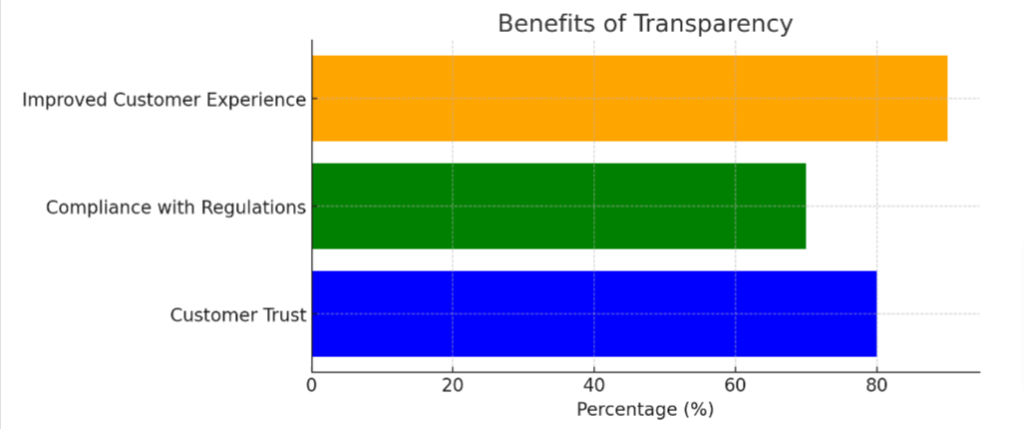Building Trust: The Importance of Transparency in Writing
In today’s world, customers want to know what businesses do with their information. Did you know that 86% of people say transparency from businesses is more important than ever? Our blog post will guide you through the steps to keep your customer relationships clear and honest.
Keep reading – it’s how trust starts!
Key Takeaways
- Being honest and straightforward in all communications builds trust and loyalty with customers. It’s important for businesses to use simple language, be consistent, and provide clear explanations about their products or services.
- Customers appreciate having control over their personal data. Companies should allow them to manage privacy settings and choose how their information is shared, meeting high expectations of transparency.
- Delivering real value in return for customer data—like personalized offers or recommendations—encourages sharing and strengthens the relationship between business and customer.
- Transparent practices ensure compliance with privacy laws such as GDPR and CCPA, protecting the company from legal issues while building credibility with audiences.
- By understanding customers’ preferences, interests, and purchase history through ethical data use, businesses can create tailored experiences that increase satisfaction and encourage brand loyalty.
The Importance of Customer Transparency
Maintaining transparency with audiences is crucial for building trust and loyalty, standing out in a crowded market, and meeting customer expectations. Customers value honesty and openness, so it’s important to prioritize clear communication and ethical use of their data.
Building trust and loyalty
Building trust and loyalty with your audience is like growing a strong tree – it takes time, care, and consistency. Start by always being honest in your communication. Tell customers the truth about your products, services, and business practices.
This honesty shows you respect them and value their choice to engage with your brand. Ensure every message reflects integrity; avoid misleading information that could damage your reputation.
Nurturing customer relationships demands open communication. Listen to feedback and act on it quickly showing accountability for any mistakes or issues that arise. Engage in two-way communication with customers by responding to their concerns through social media or customer service channels.
By actively involving audiences in the conversation, you create an environment of trust where loyalty naturally flourishes. Authentic behavior coupled with ethical use of customer data reinforces the feeling among audiences that they’re not just transactions but valued partners in a mutually beneficial relationship.
Standing out in a crowded market
Gaining customer trust and loyalty naturally helps a brand shine amidst tough competition. Companies that commit to maintaining transparency with audiences display genuine care, which resonates with consumers seeking authenticity.
When a business is upfront about its practices, especially in handling personal information, it attracts attention and admiration. This radical honesty sets a standard for ethical behavior that distinguishes a company from rivals who may be less transparent.
Using twoway communication reinforces this distinction by involving customers directly in the dialogue about their data and preferences. It’s not just about sharing facts; it’s about demonstrating accountability every step of the way.
Customers appreciate when their voices are heard and their concerns addressed swiftly, fostering an environment where openness becomes synonymous with the brand itself. Such dedicated efforts in clear messaging do much more than retain customers—they turn them into vocal advocates for the company’s integrity and commitment to ethical use of information.
Meeting customer expectations
Customers today expect businesses to be upfront about how they collect and use personal data. They want clear communication and ethical behavior from companies when it comes to their sensitive information.
Brands that are transparent with their audiences can build strong trust, fostering loyalty and retention.
With customer expectations set high for openness, maintaining a policy of radical transparency becomes essential. This approach allows for authentic interactions between customers and brands.
It paves the way for two-way communication where feedback is not just welcomed but actively sought out. Now let’s explore what types of customer data are often shared with businesses.
Examples of Customer Data
Customer data includes personal information, purchase history, and preferences and interests. Understanding the type of data collected is crucial for maintaining transparency with audiences.
Personal information
Customers’ personal information includes details such as their name, address, contact information, and demographic data. This also encompasses more specific data like purchase history, online behavior, and preferences.
Gaining access to this kind of customer data requires a high level of trust. Businesses that collect personal information from their customers must handle it with the utmost care and respect privacy laws. The task involves securing sensitive data from unauthorized access while ensuring transparency concerning how the information will be used.
Purchase history
After understanding customers’ personal information, it’s crucial to delve into their purchase history. This data offers insights into the products or services they have previously bought, providing a clear picture of their preferences and shopping habits.
Analyzing purchase history allows businesses to anticipate future needs, personalize offerings, and tailor marketing strategies to cater to specific customer interests effectively.
Understanding these patterns helps in delivering targeted recommendations and promotions that resonate with customers’ buying behaviors.
Furthermore, leveraging this information enables businesses to identify opportunities for upselling and cross-selling while enhancing overall customer experience by offering personalized suggestions based on past purchases.
Preferences and interests
Understanding customer preferences and interests is crucial for maintaining transparency and delivering personalized experiences. By obtaining insights into what customers like, dislike, and are interested in, businesses can tailor their communication and offerings accordingly.
Analyzing data related to preferences and interests allows companies to create targeted marketing campaigns, recommend relevant products or services, and ultimately enhance the overall customer experience.
Customers expect brands to value their individual preferences and interests, making it essential for businesses to ethically use this information while communicating openly with their audience.
How to Increase Customer Transparency
Ensure that your language and formatting is clear, give customers control over their data, and deliver real value in exchange for their information. Ready to learn more about maintaining transparency with your audiences? Keep reading!
Use clear language and formatting
Crafting clear and easy-to-understand language in all customer communications is crucial for maintaining transparency. By using simple, uncomplicated wording, businesses can ensure that their audience fully comprehends the information being shared.
This approach fosters a sense of trust and openness with customers, promoting strong two-way communication and understanding. Furthermore, employing consistent formatting techniques such as bullet points or headers makes it easier for customers to navigate through complex information, enhancing the overall experience.
Clear messaging not only promotes honesty and accountability but also helps in creating trust through transparency. Customers are more likely to engage with a brand that communicates openly and authentically, leading to increased brand loyalty and retention.
Give customers control over their data
When customers have control over their data, they feel empowered and respected. Allowing them to manage their personal information, preferences, and privacy settings fosters trust and transparency.
Customers appreciate the ability to decide what data they share with businesses and for what purpose. This not only aligns with ethical use of information but also helps in building long-term relationships based on mutual understanding.
To increase customer transparency, it’s essential to give customers control over their data while honoring their choices. This proactive approach demonstrates a commitment to open communication and integrity while ensuring that customers feel valued and heard throughout their interactions.
Deliver real value in exchange for data
To build trust and encourage customers to share their data, it’s crucial to provide real value in return. This can include personalized recommendations based on their preferences, exclusive offers tailored to their interests, or improved customer service experiences.
By demonstrating the tangible benefits of sharing their information, businesses can foster a more transparent and mutually beneficial relationship with their audience.
Businesses can offer educational content, loyalty programs, or early access to new products as a way of showing appreciation for customers’ data sharing. Providing such incentives not only establishes transparency but also strengthens brand loyalty by showcasing the genuine value placed on each customer’s contribution.
The Benefits of Customer Transparency
Increased customer trust and loyalty lead to long-term customer retention and satisfaction. Honesty in customer communication also ensures compliance with data regulations and helps deliver personalized experiences.

Improved customer trust and loyalty
Enhancing customer trust and loyalty is a direct result of maintaining transparency in all interactions. When customers feel that a company is honest and open with them, they are more likely to remain loyal.
By consistently delivering on promises, using clear communication, and being transparent about how their data is used, brands can build lasting trust with their audiences.
Being transparent about business practices and decisions also helps in fostering brand loyalty. When companies value openness and honesty, it reinforces the perception of integrity which contributes to building long-term relationships with customers.
Compliant with data regulations
To maintain transparency with audiences, it is crucial to ensure that customer data handling and usage are compliant with data regulations. This includes adhering to laws such as the General Data Protection Regulation (GDPR) and the California Consumer Privacy Act (CCPA).
By following these regulations, companies can build trust and credibility with their audiences by demonstrating a commitment to ethical behavior in managing customer information.
Adhering to data regulations also helps in ensuring that customers’ personal information is protected and used ethically. This not only cultivates a sense of trust between businesses and their clientele but also aligns with expectations for clear messaging, accountability, authenticity, and integrity.
Helps deliver personalized experiences
Customer transparency helps deliver personalized experiences by enabling businesses to gather and use customer data ethically. By understanding customers’ preferences, interests, and purchase history, companies can tailor their products and services to meet individual needs.
This not only enhances the overall customer experience but also strengthens brand loyalty and trust. Additionally, transparent communication about data usage fosters a sense of openness with customers while allowing for two-way communication that builds trust and accountability.
Incorporating ethical use of customer data into business practices is crucial for creating consistent value delivery and designing for customer trust and transparency. It enables businesses to communicate openly with customers, resulting in an authentic relationship built on honesty and integrity.
Conclusion
In conclusion, transparency with audiences is crucial for building trust and loyalty. Communicating openly and honestly helps meet customer expectations and stand out in the market.
Maintaining transparency not only complies with regulations but also leads to improved customer experiences and long-term brand loyalty. Being transparent about data usage, communication, and value delivery are essential elements of maintaining strong relationships with audiences.

